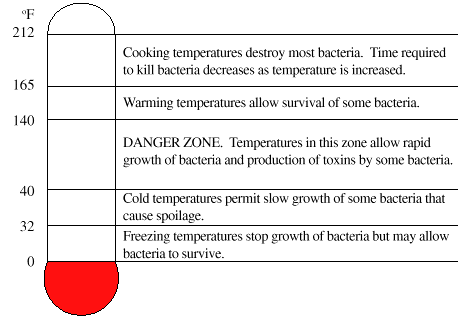BACTERIA
Common foodborne illnesses (food poisoning) are caused by bacteria or by the toxic substances they produce. Harmful bacteria are commonly present in soil, raw meat, raw (unpasteurized) milk, pets, bugs, rodents, sneezes, coughs, and unwashed hands. These bacteria can cause problems if they come in contact with food and are allowed to grow.
| Avoid
raw eggs, meat, and seafood.
Stuff meat and poultry just before roasting or bake dressing in a separate dish. Any stuffing should reach a temperature of 165 o F. |
FOOD
Bacteria grow rapidly on protein-rich foods that are usually considered perishable such as eggs, milk, and meat. Bacteria do not grow as rapidly on fruits or vegetables. Gravies, stuffings, and bread can be special problems when they come into direct contact with meat.
TIME
Bacteria need time to grow. It takes a large number of bacteria to cause human illness.
Internal
Temperature Cooking Chart
Hamburger patty 155o F
Pork 160o F
Beef 145o F
Poultry (white meat) 170o F
(dark meat) 180o F
PREPARATION
| Keep
Everything Clean Keep hands and equipment that touch food clean, since bacteria can be transferred from pets, hands, and utensils to food. Clean can openers, cutting boards, and knives thoroughly each time you use them. Cutting boards should be sanitized with a solution of 2 teaspoons liquid chlorine bleach in 1 quart of water after contact with meat, poultry, or dairy products. Rinse cutting board thoroughly after sanitizing. |
Bacteria can be transferred from un-washed hands or unclean work surfaces to food. Bacteria can also be transferred from one food to another through direct contact (for example, turkey and dressing) or by using the same utensil to prepare two or more foods (for example, using the same knife to cut up a chicken and to dice potatoes for salad). Keep everything clean.
| Microwave
Safely If using the "defrost" setting, cook food immediately. Reheat thoroughly. Follow microwave directions for thorough cooking-cover, rotate, allow for stand time-as recipe directs. |
Bacteria grow more quickly at warm temperatures than at cold temperatures. Cooking thoroughly will kill bacteria. The diagram below illustrates how temperature can affect bacterial growth. In general, remember that, if a food feels comfortable to touch, bacteria are growing rapidly.
|
Keep Hot Foods Hot Keep Cold Foods Cold
|

Reprinted by Libby Hoyle, Extension Food and Nutrition Specialist.
The Clemson University Cooperative Extension Service offers its programs to people of all ages, regardless of race, color, sex, religion, national origin, or disability and is an equal opportunity employer. Clemson University Cooperating with U.S. Department of Agriculture, South Carolina Counties. Issued in Furtherance of Cooperative Extension Work in Agriculture and Home Economics, Acts of May 8 and June 30, 1914
Disclaimer and Reproduction Information: Information in NASD does not represent NIOSH policy. Information included in NASD appears by permission of the author and/or copyright holder. More